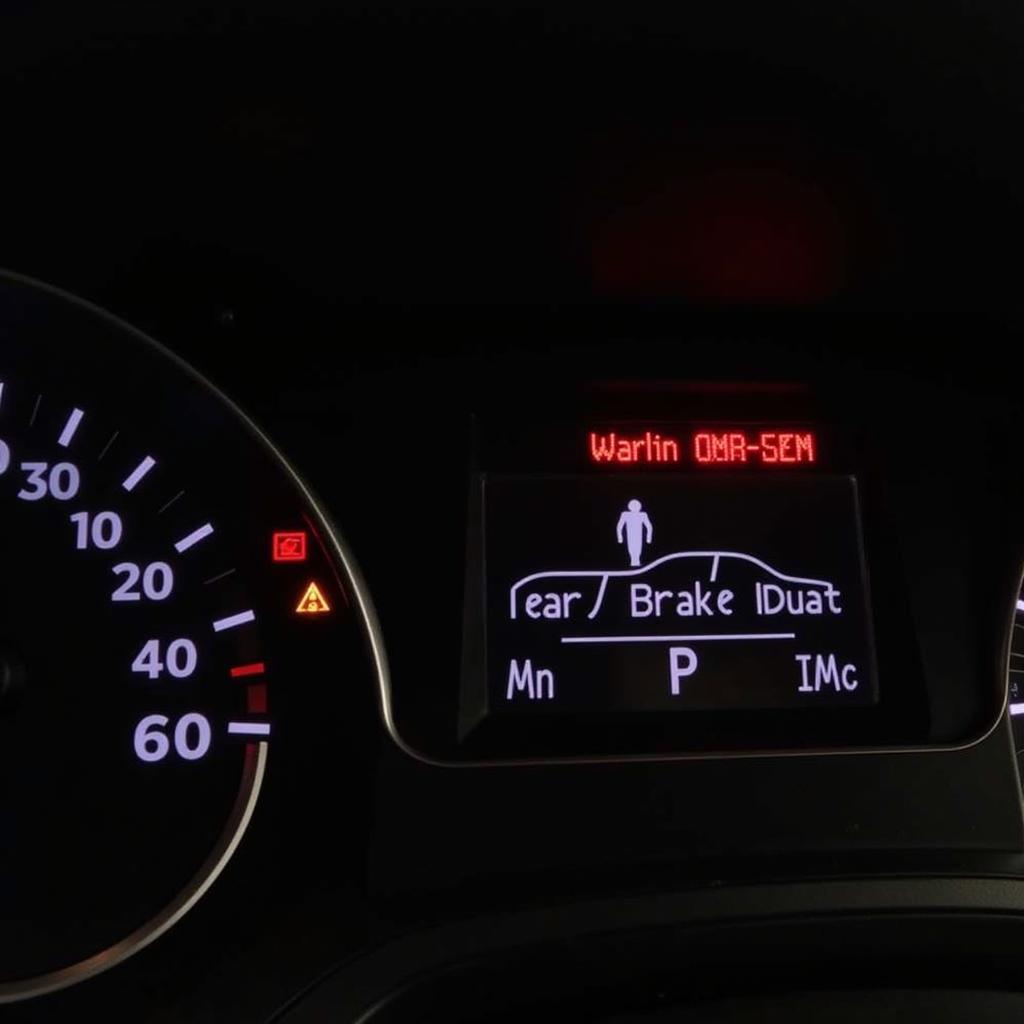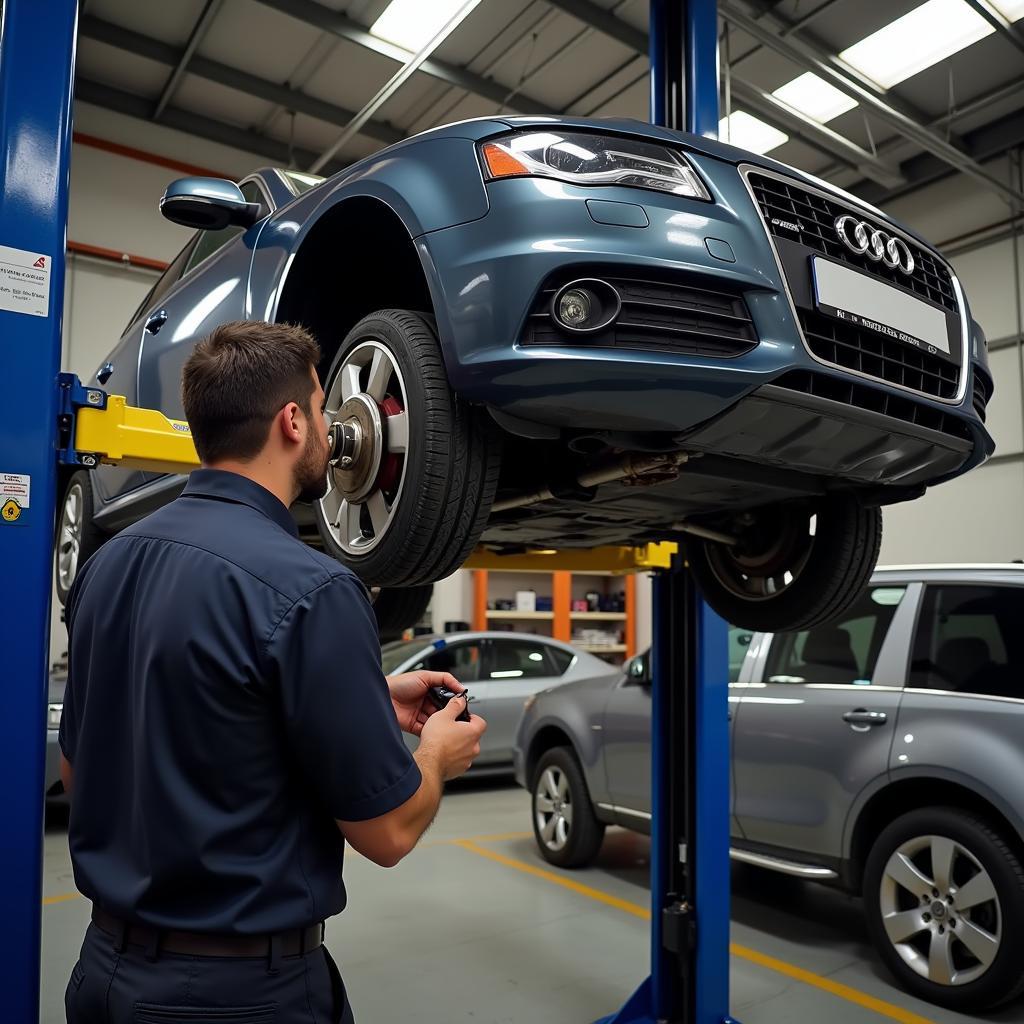The parking brake malfunction warning light on your 2010 Audi A4 can be an unwelcome sight. This issue can range from a minor annoyance to a significant safety concern, depending on the underlying cause. This article will delve into the common causes of this warning light, how to diagnose the problem, and potential solutions to get your Audi A4 back in top shape.
Common Causes of a Parking Brake Malfunction Warning Light
While the appearance of the parking brake malfunction warning light can be alarming, it’s important to remember that there are several potential causes, many of which are simple to fix. Let’s explore some of the most frequent culprits:
- Parking Brake Not Fully Released: The most straightforward explanation is often the most likely. It’s possible the parking brake isn’t fully disengaged. Always double-check your parking brake lever to ensure it’s completely down.
- Faulty Brake Light Switch: Your Audi A4 uses a brake light switch to signal the parking brake system. If this switch malfunctions, it can trigger the warning light even if the parking brake is functioning correctly.
- Low Brake Fluid: Low brake fluid levels can also cause the parking brake malfunction light to illuminate. This usually indicates a leak in your brake system, requiring immediate attention.
- Worn Brake Pads or Rotors: As your brake pads wear down, the brake caliper pistons need to extend further to engage the brakes. This can sometimes trigger the warning light, especially if your pads are excessively worn.
- Faulty Parking Brake Actuator: On some Audi A4 models, an electronic parking brake actuator engages and disengages the parking brake. If this actuator fails, it can lead to the warning light appearing on your dashboard.
- Wiring Issues: Over time, the wiring within your parking brake system can become damaged or corroded. This can disrupt the signal between the various components, causing the warning light to turn on.
Diagnosing the Problem
 Audi A4 Dashboard with Parking Brake Warning Light
Audi A4 Dashboard with Parking Brake Warning Light
Identifying the root cause of the parking brake malfunction warning light requires a systematic approach. Here’s a step-by-step guide to help you diagnose the issue:
- Check the Obvious: As mentioned earlier, begin by ensuring the parking brake is fully released. If it’s not, disengage it completely.
- Inspect Brake Fluid: Locate the brake fluid reservoir under the hood of your Audi A4. Check the fluid level, ensuring it falls within the minimum and maximum markers. If the level is low, there might be a leak in your brake system, requiring immediate professional attention.
- Visual Inspection of the Parking Brake: Look for any visible damage to the parking brake mechanism, including the cables, calipers, and pads. If you notice any broken or excessively worn components, it’s crucial to address them promptly.
- Test the Brake Light Switch: The brake light switch is usually located above the brake pedal. With the engine off, depress and release the brake pedal while observing if the brake lights illuminate. If the lights don’t turn on or flicker, the switch might be faulty and need replacement.
- Scan for Diagnostic Trouble Codes: For a more precise diagnosis, consider using an OBD-II scanner to read the diagnostic trouble codes stored in your Audi A4’s computer. This can pinpoint the specific area of the parking brake system experiencing issues.
Potential Solutions
Once you’ve identified the root cause of the parking brake malfunction warning light, you can explore the appropriate solutions:
- Add Brake Fluid: If low brake fluid is the culprit, carefully top it off to the recommended level using the correct type of brake fluid specified in your Audi A4’s owner’s manual. However, it’s crucial to address the underlying leak promptly by having a qualified mechanic inspect the brake system.
- Replace Worn Components: Worn brake pads, rotors, or a faulty brake light switch are relatively straightforward replacements. While these tasks can be handled by those with mechanical experience, seeking professional help is recommended if you’re unsure.
- Address Wiring Issues: If damaged or corroded wiring is detected, repairing or replacing the affected wires is essential. This task is best left to experienced individuals familiar with automotive electrical systems.
- Consult a Professional: If the problem persists or you’re uncomfortable performing the repairs yourself, taking your Audi A4 to a qualified mechanic specializing in German vehicles is always advisable. They can accurately diagnose the issue and provide the necessary repairs using specialized tools and expertise.
Preventing Future Issues
Prevention is always better than cure. Here are some tips to minimize the chances of encountering the parking brake malfunction warning light in the future:
- Regular Maintenance: Adhering to your Audi A4’s recommended maintenance schedule, including routine brake inspections and fluid flushes, is crucial in preventing issues before they arise. This allows a mechanic to identify and address potential problems early on.
- Engage Parking Brake Gently: Avoid engaging the parking brake forcefully, especially on steep inclines. This puts unnecessary stress on the system and can lead to premature wear of components.
- Address Warning Lights Promptly: Never ignore any warning lights on your dashboard, especially those related to your brakes. Addressing them promptly can prevent minor issues from escalating into major problems.
Conclusion
The appearance of the parking brake malfunction warning light on your 2010 Audi A4 doesn’t necessarily signify a major problem. By understanding the common causes, following the diagnostic steps outlined in this article, and addressing the issue promptly, you can get back on the road safely and confidently. Remember, if you’re unsure about any aspect of diagnosis or repair, don’t hesitate to seek professional assistance from a qualified mechanic.
 Mechanic Inspecting Audi A4 Brakes in a Garage
Mechanic Inspecting Audi A4 Brakes in a Garage
FAQs about Audi A4 Parking Brake Malfunction Warning Light
Q: Can I drive my Audi A4 with the parking brake malfunction warning light on?
A: While it might be possible to drive short distances, it’s not recommended. Driving with a potential brake issue can be dangerous and lead to further damage. It’s best to diagnose and address the issue promptly.
Q: How much does it cost to fix a parking brake malfunction?
A: The cost of repair varies significantly depending on the underlying cause. A simple brake fluid top-up might be inexpensive, while replacing a faulty parking brake actuator can be more costly. Always seek a quote from a reputable mechanic for an accurate estimate.
Q: How often should I check my Audi A4’s brake fluid?
A: It’s a good practice to check your brake fluid level at least once a month and more frequently if you notice any changes in your brake pedal feel. This helps to catch potential leaks early on.
Q: Is it difficult to replace the brake light switch on an Audi A4?
A: The difficulty level can vary depending on your mechanical skills. While it’s a relatively straightforward replacement for those with experience, consulting a repair manual or seeking professional help is advisable if you’re unsure.
Q: What is the difference between the parking brake and the emergency brake?
A: In most modern cars, including the Audi A4, the terms “parking brake” and “emergency brake” are used interchangeably. They refer to the same system designed to hold the vehicle stationary.
Q: Can I reset the parking brake malfunction warning light myself?
A: While disconnecting the battery for a short period might temporarily reset the warning light, it’s crucial to address the underlying issue. If the problem persists, the light will reappear.
Q: What is the best way to engage the parking brake on an Audi A4?
A: Always engage the parking brake gently, especially on inclines. After coming to a complete stop, pull the parking brake lever until you feel resistance, ensuring the vehicle is secure. Avoid engaging the parking brake while the car is still in motion.
